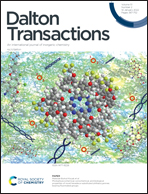Diruthenium aryl compounds – tuning of electrochemical responses and solubility†
Abstract
Reported herein are the two new series of diruthenium aryl compounds: Ru2(DiMeOap)4(Ar) (1a–6a) (DiMeOap = 2-(3,5-dimethoxyanilino)pyridinate) and Ru2(m-iPrOap)4(Ar) (1b–5b) (m-iPrOap = 2-(3-iso-propoxyanilino)pyridinate), prepared through the lithium-halogen exchange reaction with a variety of aryl halides (Ar = C6H4-4-NMe2 (1), C6H4-4-tBu (2), C6H4-4-OMe (3), C6H3-3,5-(OMe)2 (4), C6H4-4-CF3 (5), C6H5 (6)). The molecular structures of these compounds were established with X-ray diffraction studies. Additionally, these compounds were characterized using electronic absorption and voltammetric techniques. Compounds 1a–6a and 1b–5b are all in the Ru25+ oxidation state, with a ground state configuration of σ2π4δ2(π*δ*)3 (S = 3/2). Use of the modified ap ligands (ap′) resulted in moderate increases of product yield when compared to the unsubstituted Ru2(ap)4(Ar) (ap = 2-anilinopyridinate) series. Comparisons of the electrochemical properties of 1a–6a and 1b–5b against the Ru2(ap′)Cl starting material reveals the addition of the aryl ligand cathodically shifted the Ru26+/5+ oxidation and Ru25+/4+ reduction potentials. These oxidation and reductions potentials are also strongly dependent on the p-substituent of the axial aryl ligands.



 Please wait while we load your content...
Please wait while we load your content...